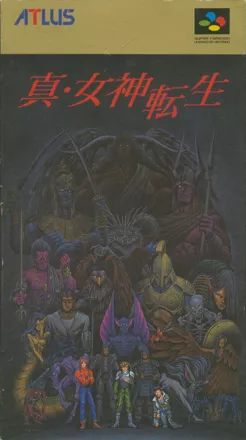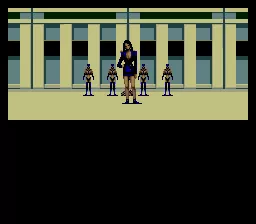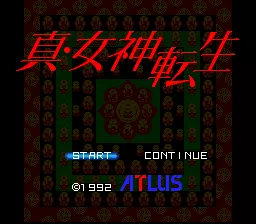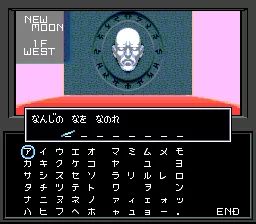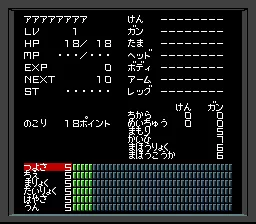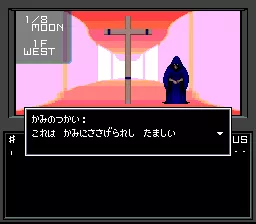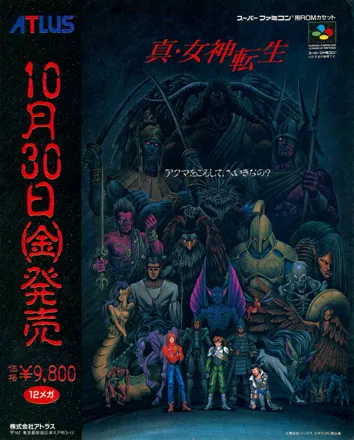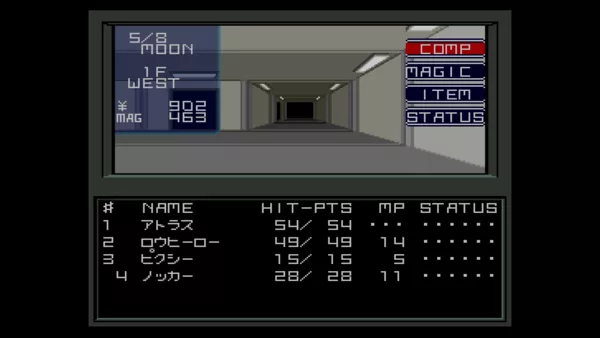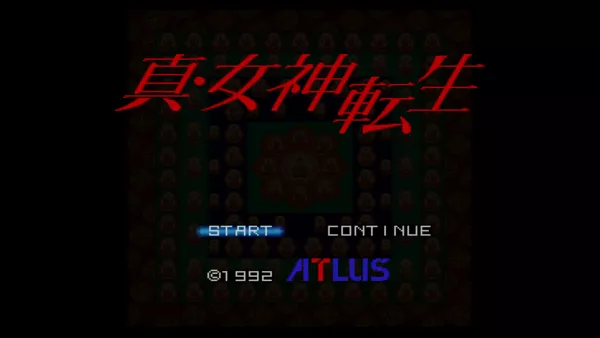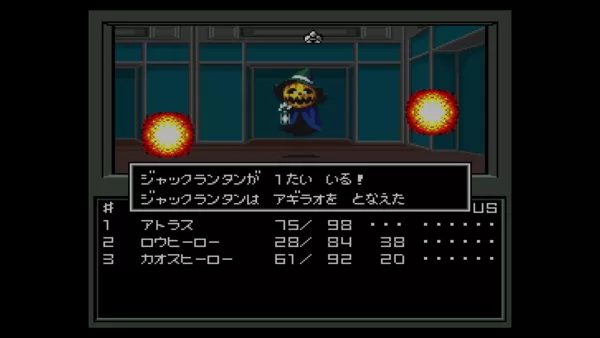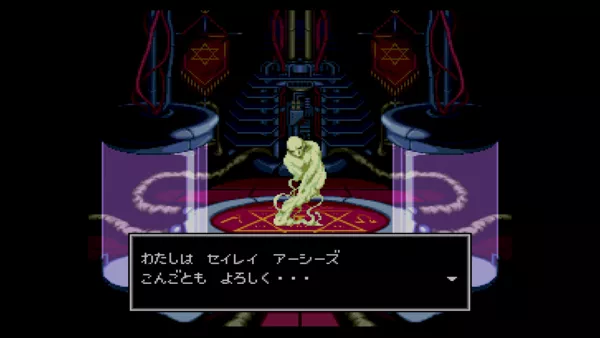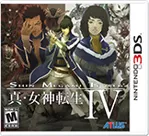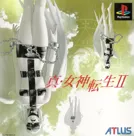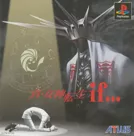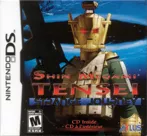Shin Megami Tensei
-
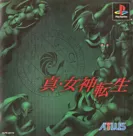 Shin Megami Tensei
(2001 on
PlayStation, 2003 on
Game Boy Advance, 2010 on
PSP...)
Shin Megami Tensei
(2001 on
PlayStation, 2003 on
Game Boy Advance, 2010 on
PSP...)
Description
A young man lives together with his mother in Kichijoji, a district in modern Tokyo. One day, he has a strange dream: he is being sucked into another dimension, a strange maze-like structure. A spirit appears in front of him and asks him his name. As he proceeds further, he meets a man who is hanging on a cross, another one who is being tormented by a demon, and a mysterious young woman who is bathing in a pool.
"Wake up!" - the voice of his mother cuts through the dream. The young man wakes up and checks his computer. Suddenly, a message arrives: the world is headed towards destruction. Only he who can summon demons through a virtual space will be able to prevent a disaster. Unable to understand what that means, the young man goes outside and finds out a murder has occurred in the nearby park. The district must be cut off from the rest of the city until the murderer is found. As the young man acquires a device that allows him to communicate with demons, he begins to realize that his role in the upcoming events may be greater than he thought.
A follow-up to the first two Megami Tensei games, Shin Megami Tensei is a first-person RPG set in modern-day and post-apocalyptic Tokyo. The hero of the game can summon demons, who consume a mysterious energy called Magnetite, which can be obtained from battles. The summoned demon joins the party and is then fully controllable by the player. The active party can include up to six characters: the hero, the heroine, and four slots usually reserved for the demons, though other human characters might also join. There is a wide variety of demons in the game, most of which are taken from real-world mythologies. The demons have levels, individual statistics, spells, special abilities, etc.
Enemy encounters are random, and the first-person combat is turn-based. During combat, human characters can use swords or guns; the heroine is also able to learn and cast magic spells. Unlike most other Japanese RPGs, the game allows the player to raise the parameters of the two main characters manually when leveling up. A major gameplay element are demon conversations, which is usually the only way to recruit demons. Typically, the player has to convince the demon to join the party by choosing appropriate dialogue lines.
All the creatures in the world of Shin Megami Tensei belong to one of the three ideologies: Law, Chaos, or Neutral. The narrative is largely dedicated to conflicts between these ideologies; during several key moments in the story, the player has to decide which one to follow. Joining one of the ideologies influences the subsequent narrative as well as some gameplay elements: certain weapons can be only equipped by a follower of a specific ideology, demons are more likely to join the hero if he shares their ideology, etc.
Spellings
- 真女神転生 - Japanese spelling
- 真女神转生 - Chinese spelling (simplified)
Groups +
- Enhanced ports / Port differences
- Gameplay feature: Auto-mapping
- Gameplay feature: Character development - Skill distribution
- Gameplay feature: Monster capture / training
- Games with original fan translations into English
- Genre: Dungeon Crawler
- Megami Tensei / Megaten universe
- Setting: 1990s
- Shin Megami Tensei series
Screenshots
Promos
Credits (SNES version)
16 People
| Programming | |
| Planning | |
| Design |
|
| Music Composed By | |
| Planning Cooperation |
|
| Producer | |
| Executive Producer |
Reviews
Critics
Average score: 83% (based on 6 ratings)
Players
Average score: 3.7 out of 5 (based on 59 ratings with 2 reviews)
Imaginative, Thought-provoking and Great Fun
The Good
It takes bold steps to try and further the RPG genre, and Shin Megami Tensei feels like it's done a long hike. This game has a few features that make it stand out from the rest, you wonder why they're rarely implemented (outside of a MegaTen game).
The Story is second to none, taking the traditional JRPG "hero wakes up", and putting it on its head. The game begins as a dream, where you decide your name, and the names of your friends. You can tell this is no simple Good vs Evil tale, which is a theme running through the whole game with many factions adopting aligning either side, both with compelling reasons to join, but also with horrible consequences.
Demons pop-up at random that you may fight, or talk to. It's clear where Pokemon got it's ideas from. But to be able to talk to an enemy is still quite unique. Say the right things, and they may give you items, or even join your party. With a demon of a kind in your party, other demons may pop up, but will not attack you (very handy if you have a few of the common types), and give you gifts and advice.
The world is expansive, and it never feels like you're being lead by the nose. Though it does have a claustrophobic atmosphere at times, reminiscent of System Shock. You're pretty much free to travel from place to place, getting caught up in one political or criminal plot after another.
Combining demons in your party is a great way to gain stronger allies. Tough it's annoying you can only make them in proportion to your current experience level, I'm still impressed the designers would let you see these all-powerful ones, probably to keep you interested (and it works).
The Bad
This game can be difficult. It's fine if you take your time, and level up in time. It's no as bad a grind as 7th Saga, but expect to put some time in.
You'll need to pay attention to the story and dialogue too, and the main map can be tricky - especially since you have to remember where a particular place, because there's no location names.
Whilst the sound and music aren't bad, they aren't great either. I don't regret playing this muted with other music playing, which you can take either way.
The Bottom Line
Demonic Socially-adept Pokemon, 15 years ahead of its time. A deep, dark adventure for those who may be a little fed up of the regular JRPG champ: Final Fantasy.
SNES · by Heathen Gray (17) · 2008
Teaching Japanese RPGs some tricks
The Good
A follow-up to two early Megami Tensei games, Shin Megami Tensei is commonly seen as the most important and influential game of the huge Megaten universe.
Unlike the overwhelming majority of Japanese RPGs, you create the four main characters (Hero, Heroine, Law Hero, and Chaos Hero) yourself. Every time your characters gain a level you can distribute skill points to raise their strength, intelligence, magic, speed, stamina, or luck. Strangely, the game takes away two of those characters permanently rather early in its course, and after a while you realize that the Hero can only be a fighter, while the Heroine is the essential magic user.
What really sets the game apart from pretty much every other RPG are demon summoning and conversations. Long before Pokemon, the creators of Megaten came up with the idea of summoning demons, making them fight for you, and fusing them to get more powerful species. Contact with the demons occupies a very important place in the gameplay of Shin Megami Tensei, making simple random turn-based battle a completely different experience from the usual RPG routine. This is one of the rare games in which you can communicate with your enemies; they aren't just enemies, but also your potential allies.
Once you managed to recruit a demon, you can summon it at any time to join your party. Summoning costs money, and while wandering around with you, demons consume a special energy called magnetite (which you get from negotiating with random enemies or from defeating them); once you run out of it, the demons die. Perhaps the most interesting aspect of this demonic gameplay is demon fusion. You can fuse two or three demons into a new one. Sometimes you produce weak demons of lower levels, sometimes you can't get anything, but often you can fuse a very powerful demon from two or three weak ones. The sheer amount of programming that went into conversations, demon classification, fusion possibilities etc., is astounding. You can spend hours trying to fuse the strongest demons, customizing your party in so many ways that the experience almost becomes overwhelming.
A very cool feature of Shin Megami Tensei its the choice of alignment, which affects the progression of the game's ending segment, as well as some gameplay-related choice. You can choose to side with the forces of Law, the forces of Chaos, or fight them both. The Law side is, essentially, a caricature of Christianity - a stereotypical fanatical religious order (actually serving archangel Michael and, by extension, God in the game) that suggests to wipe out all unbelievers. The Chaos stands for anarchic freedom, but does so with considerable ferocity, striving for a world order where only the strongest survive. The Neutral path is represented by a Taoist deity and, on one hand, preaches indifference to either Law or Chaos, and on other hand, recommends to annihilate the followers of both.
In order to present a complete picture of struggling Law and Chaos forces, the designers of the game did a massive research on mythology, and the result was the most comprehensive compendium of various mythological figures I've ever saw in a game. All the supernatural beings are united into a very complex structure, which is based on Law/Chaos as well as Light/Dark axis. Countless characters from different mythologies of the world are systematically entered into the catalog of demons that is divided into families and races.
The Bad
The graphics are unfortunately quite poor. The locations of the game are too much alike. It is basically the same dungeon in different colors - except the cathedral, which has some additional design details. Because the first-person perspective movement is so limited, you can't help feeling you are in some kind of a mathematical, unnatural, completely square world, where you can't move normally and where everything looks the same.
There are too many random battles in the game. Often enemies pop out literally at every step. It is hard enough to explore the mazes even without the enemies, but when they appear every couple of seconds, it becomes even more tedious.
A serious flaw of the game is its save system. Japanese RPGs usually offer restricted possibilities for saving - save points, world map, etc. But in most of them there are quite fair opportunities to save. In Shin Megami Tensei, you can save only at terminals. A whole district usually has one such terminal, and many dungeon areas don't have them at all. Imagine fighting your way through three or four huge floors infested with mazes, random enemies, and bosses, dying against the dungeon boss, and having to restore the game from the last save... it can literally drive you crazy. That's why I recommend using the teleportation spell when you notice things aren't looking good: better to backtrack through the dungeon again, but with all the treasures taken, bosses defeated, and - most importantly - ways mapped, than taking a risk of doing everything from the beginning.
With all its clever touches, Shin Megami Tensei only gravitates towards the (in my opinion far superior) Western RPG design school, but doesn't really follow it in certain core aspects. Its progression is still quite formulaic and linear - with very few exceptions, the game takes your hand and drags you through its locations in a strict order. Compare this, for example, to Might and Magic games, where the player has complete freedom of movement and exploration, and where many locations are optional. Even the famed dungeons of Shin Megami Tensei are somewhat deceptively complex: there is, in fact, always only one route to the goal in them, and it's always rather obvious. Unlike truly deep dungeon-exploring games such as, for example, the sixth Wizardry, there are no puzzles and no thinking involved when exploring the dungeons - you just follow the map.
The Bottom Line
Shin Megami Tensei combines a typically Japanese world-embracing, quasi-philosophical narrative with somewhat Western RPG-style gameplay (active leveling up, party customization, etc.), and then adds to that its own interesting demon-summoning system and ethical choices. Thus - though it doesn't quite hold its ground against contemporary Western RPGs - it does teach the Eastern sub-genre something important.
SNES · by Unicorn Lynx (181799) · 2018
Discussion
| Subject | By | Date |
|---|---|---|
| Demon's alignment | Donatello (466) | May 22nd, 2008 |
| God or Devil? | Unicorn Lynx (181798) | Jul 7th, 2007 |
Trivia
References
Shin Megami Tensei series contain a lot of characters from Western mythology, including YHVH, the God of ancient Israel, who later also became God the Father in Christianity (!). This was one of the reasons why the series never saw green light for North American or European releases.
Title translation
Shin Megami Tensei roughly means "True Reincarnation of the Goddess". The game itself has nothing to do with any reincarnations of goddesses: the title refers to the first game of Megaten universe, Digital Devil Monogatari - Megami Tensei for NES.
Translation patch
On June 30th, 2002, Aeon Genesis released a complete Japanese-to-English patch for the SNES release.
Version differences
Shin Megami Tensei, originally appearing on Super Famicom (SNES), was later ported to Turbo CD, SEGA CD, PlayStation, and GBA. Here is an overview of the changes made to the game in different releases: * The most faithful port is the Turbo CD one. Almost nothing was changed, graphics are roughly the same quality, interface, and gameplay are totally the same. The only addition is some voice acting during the intro;
-
The SEGA CD port got an important graphical overhaul. It featured a brand new intro and other cut scenes with digitized graphics and voice-overs. Dungeon graphics became much more refined (dungeons were composed of simple tiles of different colors, without any decorations, in SNES and Turbo CD versions), with unique design patterns for different dungeons. It was possible to see multiple enemies of the same kind on-screen during battles. Perhaps most importantly - character graphics were completely redone. Instead of simple sprites SEGA CD version features digitized portraits;
-
The PlayStation release does not include the intro and the character art unique to SEGA CD version. Instead, it features more detailed graphics. Rooms that were empty in SNES and Turbo CD versions, and had a couple of token furniture pieces in SEGA CD version now actually look like real rooms. Dungeon scrolling became much more smooth, in a 3D fashion. Dungeon graphics look differently from both original and SEGA CD versions, but with high resolution graphics. There is also a new, easier difficulty level. The interface was updated to look like in Shin Megami Tensei II;
-
Lastly, the Game Boy Advance version looks pretty much the same as the PlayStation one, minus some graphical details and the additional difficulty level.
Another interesting fact is censorship level. There is one particular scene in the game where three robed summoners are performing a ritual. In Turbo CD and SEGA CD versions the two helpers are naked below their waists. However, they wear pants in SNES and PlayStation versions.
Analytics
Related Sites +
-
AGTP
Contains an English translation patch to Shin Megami Tensei SNES ROM -
COMP
A fan site dedicated to Shin Megami Tensei and other Megaten games -
Shin Megami Tensei FAQs
Here is the FAQ mentioned in the trivia section. Seems to be the best one out there...
Identifiers +
Contribute
Are you familiar with this game? Help document and preserve this entry in video game history! If your contribution is approved, you will earn points and be credited as a contributor.
Contributors to this Entry
Game added by Unicorn Lynx.
Wii U added by Michael Cassidy. Nintendo Switch added by Rik Hideto. Wii added by gamewarrior.
Additional contributors: Indra was here, Alaka, SGruber.
Game added November 5th, 2003. Last modified December 18th, 2023.
